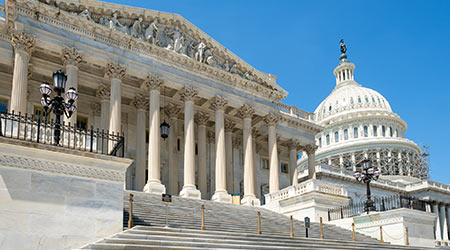
House Cuts Energy Star Funding by 26%
October 3, 2017
The Energy Star budget would be slashed under a funding measure approved by the House of Representatives. The bill preserves the Energy Star program but reduces the program’s budget to $31 million. According to an EPS spokesman, the FY 2017 budget for Energy Star is $42.1 million. That translates into a budget cut of more than 26 percent.
The Energy Star Portfolio Manager tool is widely used by facility managers who want to reduce energy consumption. Portfolio Manager provides free, online benchmarking against comparable buildings. More than 450,000 commercial buildings, representing more than 40 billion square feet of space, are actively measuring and tracking their energy use, according to Energy Star.
The House report accompanying the bill said that it “continues to support the Energy Star program and does not terminate the program as proposed” by the Trump administration. But it said that “program adjustments or reforms may be warranted.”
In justifying the budget cut, the committee cited two points.
One is a 2009 agreement between EPA and the U.S. Department of Energy that reallocated roles and responsibilities between the two. The report called for those responsibilities to be reviewed.
The committee report also said that because of a 2011 transfer of product review responsibilities to outside vendors, past EPA funding levels “exceed the needs for internal product reviews leading to the recommended level of $31,000,000 for fiscal year 2018.”
Alliance to Save Energy spokesman Ben Somberg disputed that justification: “The rationale in the committee report for cutting this budget is flawed. The EPA has never done the certification work for Energy Star products. When they added third-party certification several years ago to better ensure compliance, it actually increased the agency's workload in terms of managing and overseeing the certifications. So the notion that Congress can simply chop funding for Energy Star because it moved to third-party testing in 2011 just doesn’t add up.”
Kateri Callahan, president of the Alliance to Save Energy, said that deep budget cuts would threaten the integrity of the program.
“Taking an ax to Energy Star would make it difficult if not impossible for the program to certify new energy-efficient products,” she said. “This would not only hurt consumers but also the more than 16,000 companies and organizations that have invested valuable time and resources to make products that qualify for Energy Star.”
ASE cited estimates that the proposed budget would represent about a 40 percent cut in funding.
ASE said that Energy Star costs about $50 million per year to administer but provided $34 billion in savings to American consumers and businesses in 2015. Energy Star estimates that its efforts save American households and businesses $430 billion on utility bills, while reducing greenhouse gas emissions by 2.7 billion metric tons since 1992.
This Quick Read was submitted by Edward Sullivan, editor of Building Operating Management magazine, edward.sullivan@tradepress.com. Click here to read more about energy efficiency on Facilitiesnet.com.
Next
Read next on FacilitiesNet












